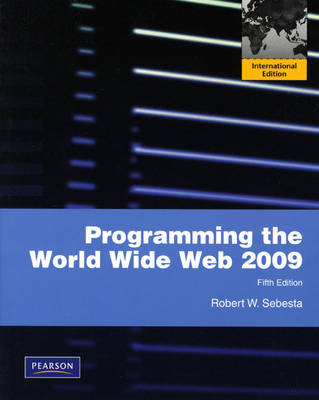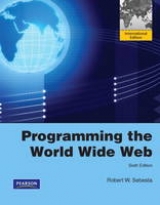
Programming the World Wide Web 2009
Pearson (Verlag)
978-0-13-136476-9 (ISBN)
- Titel erscheint in neuer Auflage
- Artikel merken
Programming the World Wide Web 2009 provides a comprehensive introduction to the tools and skills required for both client- and server-side programming, teaching students how to develop platform-independent sites using the most current Web development technology. Essential programming exercises are presented using a manageable progression: students begin with a foundational XHTML Web site and employ new languages and technologies to add features as they are discussed in the course. Readers with previous experience programming with an object-oriented language are guided through concepts relating to client-side and server-side programming, including ASP.NET using C#, JavaScript™, Java™ servlets, Ajax, JSP™, XHTML, XML, PHP, Ruby, and Rails.
SUPPLEMENTS
Lecture Slides (PPT)
Figures from the book (PPT)
Code Listing from the book
Solutions Manual (Instructors Only)
Robert Sebesta is an Associate Professor in the Computer Science Department at the University of Colorado, Colorado Springs. Professor Sebesta received a BS in applied mathematics from the University of Colorado, Boulder, and MS and PhD degrees in computer science from the Pennsylvania State University. His professional interests are the design and evaluation of programming languages, compiler design, and software testing methods and tools. He is the author of Addison-Wesley’s Concepts of Programming Languages and Programming the World Wide Web.
1 Fundamentals 1
1.1 A Brief Introduction to the Internet 2
1.2 The World Wide Web 6
1.3 Web Browsers 7
1.4 Web Servers 8
1.5 Uniform Resource Locators 11
1.6 Multipurpose Internet Mail Extensions 13
1.7 The Hypertext Transfer Protocol 15
1.8 Security 18
1.9 The Web Programmer’s Toolbox 20
2 Introduction to XHTML 35
2.1 Origins and Evolution of HTML and XHTML 36
2.2 Basic Syntax 38
2.3 Standard XHTML Document Structure 39
2.4 Basic Text Markup 40
2.5 Images 49
2.6 Hypertext Links 54
2.7 Lists 57
2.8 Tables 63
2.9 Forms 71
2.10 Syntactic Differences between HTML and XHTML 84
3 Cascading Style Sheets 91
3.1 Introduction 92
3.2 Levels of Style Sheets 93
3.3 Style Specification Formats 94
3.4 Selector Forms 96
3.5 Property Value Forms 99
3.6 Font Properties 100
3.7 List Properties 106
3.8 Color 110
3.9 Alignment of Text 112
3.10 The Box Model 114
3.11 Background Images 119
3.12 The and Tags 121
3.13 Conflict Resolution 122
4 The Basics of JavaScript 129
4.1 Overview of JavaScript 130
4.2 Object Orientation and JavaScript 133
4.3 General Syntactic Characteristics 134
4.4 Primitives, Operations, and Expressions 137
4.5 Screen Output and Keyboard Input 146
4.6 Control Statements 150
4.7 Object Creation and Modification 158
4.8 Arrays 159
4.9 Functions 164
4.10 An Example 169
4.11 Constructors 170
4.12 Pattern Matching Using Regular Expressions 171
4.13 Another Example 176
4.14 Errors in Scripts 177
5 JavaScript and XHTML Documents 185
5.1 The JavaScript Execution Environment 186
5.2 The Document Object Model 187
5.3 Element Access in JavaScript 190
5.4 Events and Event Handling 193
5.5 Handling Events from Body Elements 198
5.6 Handling Events from Button Elements 199
5.7 Handling Events from Text Box and Password Elements 205
5.8 The DOM 2 Event Model 215
5.9 The navigator Object 220
5.10 DOM Tree Traversal and Modification 222
6 Dynamic Documents with JavaScript227
6.1 Introduction 228
6.2 Positioning Elements 228
6.3 Moving Elements 234
6.4 Element Visibility 237
6.5 Changing Colors and Fonts 238
6.6 Dynamic Content 242
6.7 Stacking Elements 245
6.8 Locating the Mouse Cursor 248
6.9 Reacting to a Mouse Click 251
6.10 Slow Movement of Elements 252
6.11 Dragging and Dropping Elements 255
7 Introduction to XML 263
7.1 Introduction 264
7.2 The Syntax of XML 266
7.3 XML Document Structure 269
7.4 Document Type Definitions 270
7.5 Namespaces 277
7.6 XML Schemas 279
7.7 Displaying Raw XML Documents 287
7.8 Displaying XML Documents with CSS 289
7.9 XSLT Style Sheets 291
7.10 XML Processors 300
7.11 Web Services 302
8 Introduction to Flash 309
8.1 Origins and Uses of Flash 310
8.2 A First Look at the Flash Authoring Environment 310
8.3 Drawing Tools 315
8.4 An Example–Static Graphics 322
8.5 An Example–Animation and Sound 329
8.6 User Interactions 336
9 Introduction to PHP 345
9.1 Origins and Uses of PHP 346
9.2 Overview of PHP 346
9.3 General Syntactic Characteristics 347
9.4 Primitives, Operations, and Expressions 348
9.5 Output 354
9.6 Control Statements 356
9.7 Arrays 359
9.8 Functions 368
9.9 Pattern Matching 371
9.10 Form Handling 374
9.11 Files 380
9.12 Cookies 383
9.13 Session Tracking 386
10 Introduction to Ajax 393
10.1 Overview of Ajax 394
10.2 The Basics of Ajax 397
10.3 Return Document Forms 407
10.4 Ajax Toolkits 411
10.5 Security and Ajax 419
11 Java Web Software 423
11.1 Introduction to Servlets 424
11.2 The NetBeans Integrated Development Environment 428
11.3 A Survey Example 437
11.4 Storing Information on Clients 444
11.5 JavaServer Pages 454
11.6 JavaBeans 465
11.7 JavaServer Faces 470
12 Introduction to ASP.NET 485
12.1 Overview of the .NET Framework 486
12.2 A Bit of C# 489
12.3 Introduction to ASP.NET 493
12.4 ASP.NET Controls 500
12.5 ASP.NET AJAX 518
12.6 Web Services 525
13 Database Access through the Web 535
13.1 Relational Databases 535
13.2 An Introduction to the Structured Query Language 538
13.3 Architectures for Database Access 543
13.4 The MySQL Database System 546
13.5 Database Access with PHP and MySQL 548
13.6 Database Access with JDBC and MySQL 557
14 Introduction to Ruby 569
14.1 Origins and Uses of Ruby 570
14.2 Scalar Types and Their Operations 570
14.3 Simple Input and Output 579
14.4 Control Statements 581
14.5 Fundamentals of Arrays 586
14.6 Hashes 592
14.7 Methods 594
14.8 Classes 598
14.9 Blocks and Iterators 604
14.10 Pattern Matching 607
15 Introduction to Rails 613
15.1 Overview of Rails 614
15.2 Document Requests 616
15.3 Rails Applications with Databases 623
15.4 Rails with Ajax 643
Summary 651
Review Questions 653
Exercises 654
Appendix A Introduction to Java 655
Appendix B Named Colors and Their Hexadecimal Values 671
Appendix C Java Applets 675
Index 703
| Erscheint lt. Verlag | 30.4.2009 |
|---|---|
| Sprache | englisch |
| Maße | 185 x 231 mm |
| Gewicht | 1012 g |
| Themenwelt | Mathematik / Informatik ► Informatik ► Web / Internet |
| ISBN-10 | 0-13-136476-6 / 0131364766 |
| ISBN-13 | 978-0-13-136476-9 / 9780131364769 |
| Zustand | Neuware |
| Haben Sie eine Frage zum Produkt? |
aus dem Bereich



